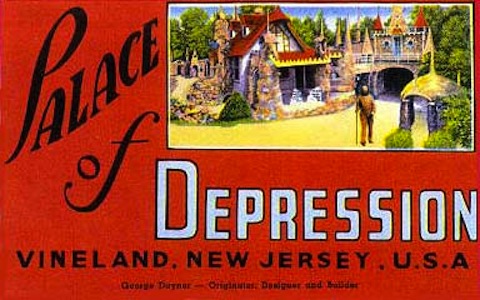
I’d wager that there isn’t a single state in the nation that lacks an architectural oddity dubbed something like “The Strangest House in the World.” You know what I’m talking about—that random tourist attraction that lies somewhere between two medium-sized towns, and is a testament to mankind’s ability to develop total (and somewhat frightening) tunnel vision when a project captures the imagination.
My personal favorite has long been Wisconsin’s House on the Rock, which grew out of a frustrated architect’s desire to one-up Frank Lloyd Wright. But it sounds as if I would have been an even greater sucker for New Jersey’s aptly named Palace of Depression, built during the Great Depression by George Daynor, a man who could charitably be described as being one can short of a six-pack. Daynor maintained a psychologically even keel during the Palace’s early years, as the challenge of building and maintaining the place acted as a sort of Colzapine. But he lost the plot during the 1950s, and his desperate attempt to maintain the Palace’s fame led to his bizarre downfall:
In 1956, Daynor gave the FBI a false tip as it was pursuing the kidnappers of a lost four-year-old boy. He said the suspects had recently been to the palace; his bald lie garnered him a year behind bars. By his own reckoning Daynor was 98 years old when he was sprung in 1958. Too feeble to keep up the palace, he wandered about Vineland wearing rouge on his cheeks and bobby pins in his hair. Even before his death in 1964 his home was slowly disintegrating.
From a psychological perspective, I’m interested in how dedication to specific tasks can help counter the symptoms of mental illness. I’m currently working on a major project that involves a similar situation—a person who dealt with multiple serious mental disorders by losing himself in intricate planning. I reckon that there is probably a pretty simple neuroscientific explanation for this—perhaps one can quiet rebellious parts of the mind by making sure that all the neurons are firing elsewhere.


scottstev // Mar 7, 2011 at 11:19 am
I heard of an acquaintance whose father was bipolar. The manic phases would manifest themselves with a project to build a deck for the home. Her heart would sink every time she saw the blueprints and lumber dug out and ready to go. I wonder if this might not be the case, that productivity and planning are part of a manic episode.
Gramsci // Mar 7, 2011 at 12:31 pm
Duh, planning!
It’s worth thinking about the difference between those whose mind tends to excel with one organizational task (e.g. Stephen Wiltshire) vs. a person whose focus on a task, whether or not it’s done at a superhuman level, fends off (worse) mental health problems. One could imagine that a concerted effort to concentrate on one simple task could run counter to the expansive, grandiose free-association sometimes seen in manic episodes.
Perhaps such task could help one, to quote Ogden Nash, “kindly unhitch that wagon” from Emerson’s star. Emerson was a total tiger-blooded warlock, btw.